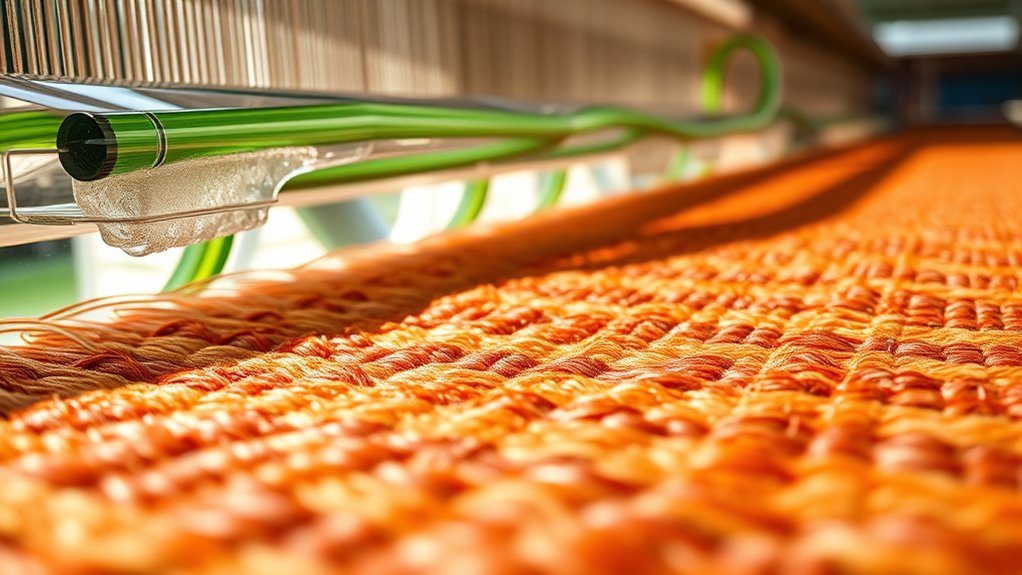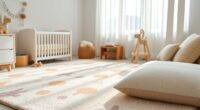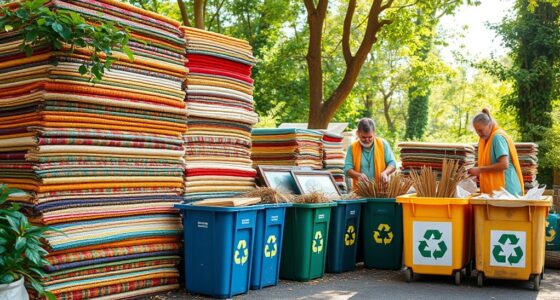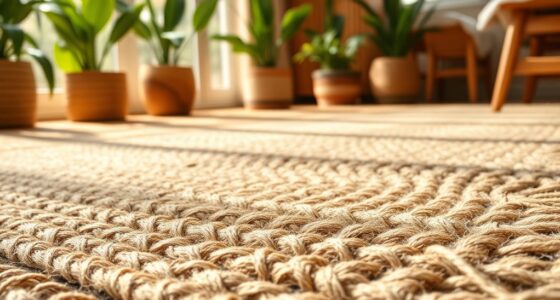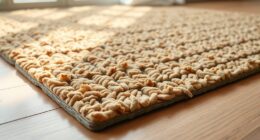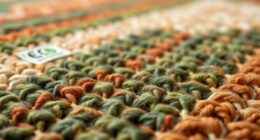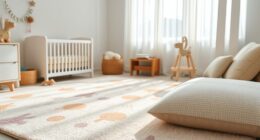By adopting water-efficient practices in rug production, you can considerably cut resource use and lower environmental impact. Using eco-friendly dyes, recycling fibers, and employing advanced monitoring systems help reduce water consumption and pollution. Optimizing machinery with closed-loop systems and alternative cleaning methods further conserves water and energy. These strategies promote sustainable manufacturing, protect ecosystems, and support eco-conscious choices. Keep exploring to discover how these innovative techniques can transform your manufacturing process efficiently.
Key Takeaways
- Utilizing eco-friendly dyes and shorter processing times reduces water consumption and chemical runoff.
- Implementing water monitoring systems optimizes usage and identifies waste reduction opportunities.
- Using recycled fibers minimizes reliance on water-intensive virgin materials and promotes waste reuse.
- Machinery improvements like closed-loop systems and alternative cleaning methods decrease overall water use.
- Eco-conscious practices conserve water resources and reduce pollution, supporting sustainable rug manufacturing.

Creating rugs with water efficiency in mind not only helps conserve this essential resource but also reduces the environmental impact of production. When you prioritize water-saving techniques, you’re supporting a more sustainable approach that minimizes waste and lowers your ecological footprint. One effective way to achieve this is by adopting sustainable dyes, which use less water and fewer harmful chemicals compared to traditional dyeing methods. These dyes often require shorter processing times and can be applied using innovative techniques that drastically cut down on water consumption, making the entire process more eco-friendly. By choosing sustainable dyes, you’re not just reducing water use; you’re also helping prevent pollution caused by chemical runoff, which can harm local ecosystems and communities. Additionally, implementing water monitoring systems can help producers track and optimize water usage throughout the manufacturing process for even greater efficiency.
In addition to selecting eco-conscious dyes, incorporating recycled fibers into your rug production plays a significant role in conserving water. Recycled fibers are made from post-consumer or post-industrial waste, such as plastic bottles, textile scraps, or old rugs, which are processed into new, high-quality materials. Utilizing these fibers reduces the need for virgin material extraction, which is often water-intensive, and minimizes waste that would otherwise end up in landfills. When you opt for recycled fibers, you’re contributing to a circular economy where resources are reused rather than discarded, further lowering the environmental footprint of your rugs.
Implementing water-efficient practices in your manufacturing process also involves optimizing machinery and techniques to reduce water use at every stage. For example, using closed-loop systems that recycle water within the production cycle ensures minimal waste and contamination. You might also consider alternative cleaning methods that require less water, such as dry cleaning or ultrasonic cleaning, which can maintain quality without excessive water consumption. These practices not only save water but also lower your energy costs, making your operation more sustainable overall.
Frequently Asked Questions
What Are the Environmental Benefits of Water-Efficient Rug Production?
By choosing water-efficient rug production, you considerably reduce the water footprint, conserving essential freshwater resources. Using eco-friendly dyes minimizes chemical runoff, protecting ecosystems and improving air quality. This eco-conscious approach also lowers energy consumption and waste, making your rugs more sustainable. You help promote environmental health, support responsible manufacturing, and contribute to a greener future by prioritizing water efficiency and eco-friendly materials in your rug choices.
How Does Water Conservation Impact Rug Quality and Durability?
Like a gentle stream nourishing a river, water conservation guarantees your rug maintains fiber quality and dye absorption. When you use less water, you reduce stress on fibers, enhancing durability and preventing weakening over time. This careful process leads to a rug that stays vibrant and strong longer, proving that smart water use doesn’t compromise quality but actually supports a beautiful, lasting product. You get durability without sacrificing excellence.
Are Water-Efficient Methods Cost-Effective for Manufacturers?
Yes, water-efficient methods are cost-effective for manufacturers. By conducting a thorough cost analysis, you can see that the initial investment in water-saving technology often leads to lower operational costs over time. Although there might be some implementation challenges, such as staff training and equipment upgrades, the long-term savings on water bills and environmental benefits outweigh these hurdles. Ultimately, adopting water-efficient practices boosts your sustainability and profitability.
What Innovations Are Emerging in Water-Saving Rug Manufacturing?
Emerging innovations in water-saving rug manufacturing include using eco-friendly dyes and recycled fibers. You’ll find manufacturers adopting these eco-conscious materials to reduce water consumption markedly. Eco-friendly dyes require less rinsing and produce fewer pollutants, while recycled fibers cut down on resource use overall. These advancements not only save water but also appeal to environmentally conscious consumers, making your production more sustainable and cost-effective in the long run.
How Can Consumers Identify Water-Efficient Rugs?
Imagine you’re in a time machine, and today, you can spot water-efficient rugs easily. Look for labels indicating eco-friendly practices, and check for certifications like Green Seal. Focus on fiber quality—high-quality fibers often mean less dyeing, which saves water. Also, inquire about dyeing processes; water-efficient methods use less dye and water. Choosing these rugs helps you save resources and supports sustainable manufacturing every time you walk on your new rug.
Conclusion
By adopting water-efficient rug production methods, you can markedly cut water usage—up to 50% in some cases—saving resources and reducing environmental impact. Imagine creating beautiful, durable rugs while conserving enough water to fill a swimming pool every week! Every step you take toward sustainability not only benefits the planet but also boosts your business’s reputation. Embrace these innovative practices today and make a real difference for a greener, more efficient future.
